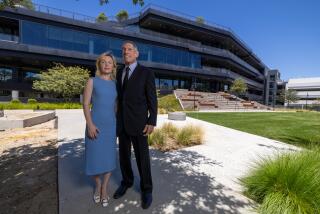L.A. architecture school SCI-Arc buys its unorthodox home
L.A.’s renegade, nomadic architecture school is finally putting down roots.
The Southern California Institute of Architecture, one of the top-rated schools in the country for design, bought itself a home in downtown Los Angeles on Thursday. SCI-Arc, as it is commonly known, paid $23.1 million for a highly unorthodox school building.
SCI-Arc bought a century-old rail freight depot that is a quarter of a mile long and about 37 feet wide. The school has been a tenant in the building for 10 years, having failed in an earlier attempt to buy the property.
The missed opportunity was emblematic of the old SCI-Arc, school officials say, as a place where being ahead of the curve on architecture was prized but the more mundane business of running an institution was not.
“We used to be considered one step ahead of the IRS, one step ahead of creditors,” Director Eric Owen Moss quipped.
Those days are over, Moss said. The school now has an experienced chief operating officer and a more worldly board of trustees that has set SCI-Arc on a path to solvency and a more grounded future.
“SCI-Arc’s capacity has evolved, and its understanding of itself as an institution has changed,” Moss said. “But I wouldn’t say SCI-Arc has gone Republican or Andrew Carnegie.”
Combative bravado seems to be one of the few traditions at a pointedly nontraditional school.
In 1972, a handful of faculty members, along with about 40 students, abruptly left Cal Poly Pomona after a rift between the dean of the school at the time and Ray Kappe, who headed the architecture department.
Among the breakaway faculty members was Thom Mayne, who went on to win a Pritzker Prize at his Santa Monica firm Morphosis Architects. Mayne returned to the SCI-Arc fold this month as trustee. Other board members include architects Frank Gehry, Michael Rotondi and William Fain, and real estate developers Kevin Ratner and Tom Gilmore.
SCI-Arc originally set up shop on a shoestring in a rented warehouse in Marina del Rey, garnering an international reputation as an avant-garde, if unaccredited, experimental school. SCI-Arc was a leader in innovative design, many agreed, but critics sniffed that it didn’t prepare students to build practical buildings or work in a conventional architecture firm.
School officials dispute that characterization while cherishing their nontraditional style. The school is now fully accredited. Students study in a densely packed studio environment, working together with teachers on assigned design projects. Desks are cluttered with computer screens, models and crumbs left behind from grueling late-night work sessions.
The setup leaves lots of room for students to learn from each other as they “yak and exhibit,” Moss said. The absence of traditional school structure also appeals to teachers who disdain academic strictures.
“Young architects from all over the world come to teach here,” he said. “You don’t have to put in 15 years to become chairman of something.”
About 30% of the school’s 500 students are from overseas, said Jamie Bennett, the school’s new chief operating officer. It was Bennett who steered SCI-Arc through the complicated transaction approved by a federal Bankruptcy Court to buy the school property from Meruelo Maddux Properties.
“Our mortgage payment will be less than our rent,” said Bennett, a former television executive who oversees daily operations at the campus, which stretches along Santa Fe Avenue from 3rd Street to the 4th Street bridge.
Meruelo Maddux, the largest owner of industrial property in downtown Los Angeles, filed for bankruptcy protection in 2009. Among its properties was the SCI-Arc campus, which was purchased in 2004 as part of a larger land acquisition for a planned apartment complex.
The sale was a surprise and disappointment to SCI-Arc leaders, who had hoped to carve out the 2.5-acre campus in a purchase of their own. Real estate industry experts said at the time that SCI-Arc moved too slowly and was outmaneuvered by better-financed competitors.
As a property owner, SCI-Arc is in for a cultural shift, said real estate lawyer Jerry Neuman, chairman of the school’s board of trustees.
“When you have never been a landlord and always a tenant, the way you view the world is different,” Neuman said.
Now, he said, SCI-Arc must contemplate such institutional building blocks as student housing and student services like a bookstore and placement office.
“It’s a huge step forward for the institution, as well as a challenge,” Neuman said.
Some brick-and-mortar amenities could help, said Los Angeles architect Douglas Hanson of Smart Architecture, at least when it comes to appealing to those who help pay tuition. Visitors first see the school as a skinny old building with a vast asphalt parking lot.
“The parents are like, ‘Are you kidding?’” Hanson said. “Now they have gotten over the first hurdle. This really does set them up to be able to provide a campus environment for the students.”
To Moss, an architect known for designing some of the most unusual office buildings in the region, the school’s location in an old but evolving district of the city is ideal. Downtown is in a dynamic state of complicated change involving business, housing, entertainment and recreation.
What will the city do with the Los Angeles River? Moss asked. How will it extend the growing vibrancy of downtown across the river to Boyle Heights?
“L.A. is on the world map, but the physical makeup of the city has a huge distance to go,” Moss said. “L.A.’s physical future and the planning future is ahead of it.”
More to Read
Inside the business of entertainment
The Wide Shot brings you news, analysis and insights on everything from streaming wars to production — and what it all means for the future.
You may occasionally receive promotional content from the Los Angeles Times.











